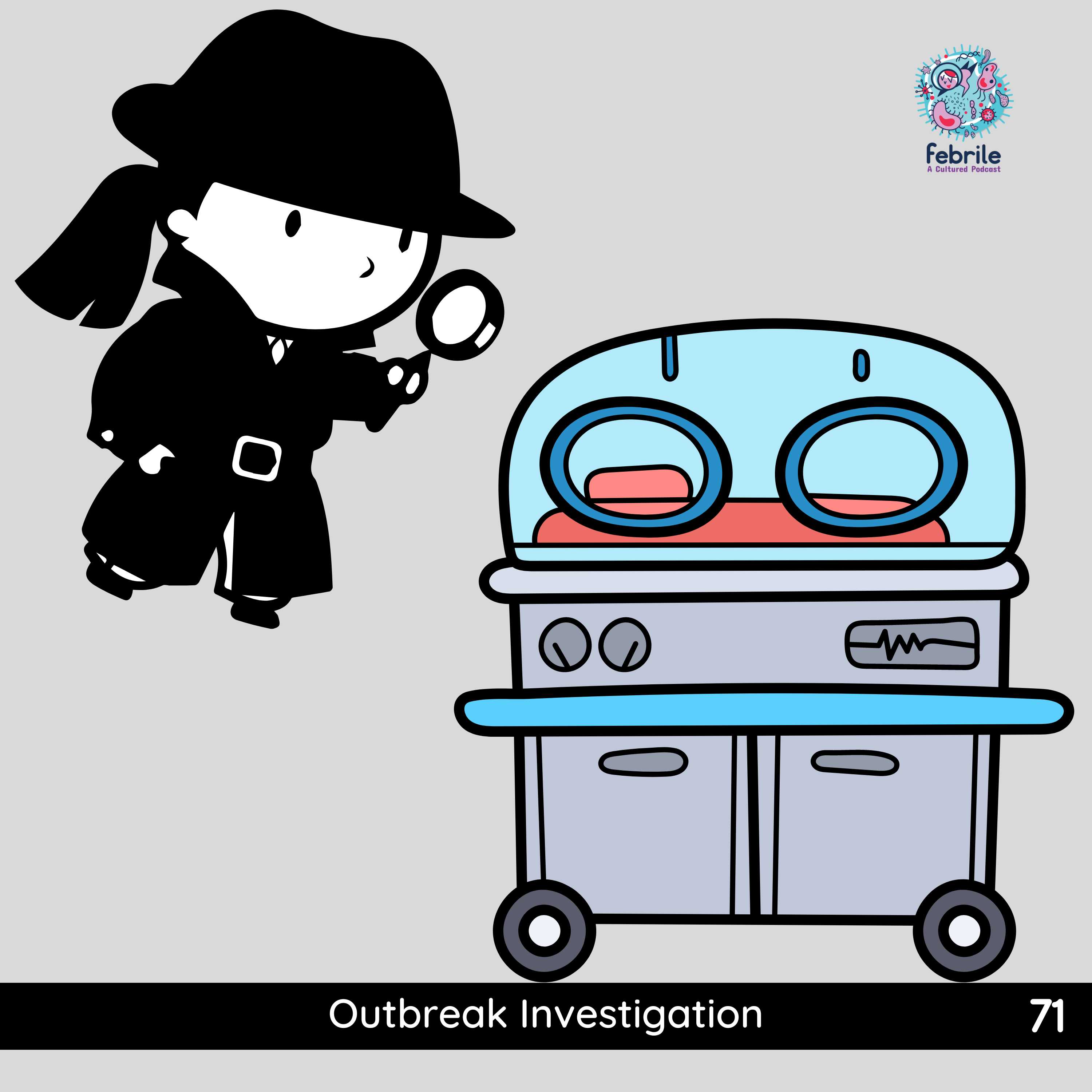Table of Contents
Credits
Hosts: Sara Dong
Guests/Writing: Annabelle de St. Maurice, Carol Vance, Allison Bartlett
Producing/Editing/Cover Art: Sara Dong
Our Guests
Annabelle de St. Maurice, MD, MPH

Dr. Annabelle de St. Maurice recently took a position as a Physician Specialist in the Acute Communicable Disease Control Unit at the Los Angeles County Department of Public Health. Prior to this, she was an Associate Professor of Pediatric Infectious Diseases and the Co-Chief Infection Prevention Officer at UCLA Mattel Children’s Hospital/David Geffen School of Medicine. In this new role, she is supervising a team that conducts syndromic surveillance using data collected from hospitals and other data sources within the community and a team that conducts outbreak investigations in schools, homeless shelters, correctional facilities, and other community settings. She also joins us as a representative of the SHEA Pediatric Leadership Council
Carol Vance, MSN, RN, PHN, CIC

Carol Vance is the multi-site director of infection prevention for Advocate Aurora Children’s Hospital and Interim Christ Medical Center. She graduated in 2017 with her MSN with emphasis in Leadership from Webster University. Ms. Vance has 16 years of nursing experience in the areas of critical care, infection prevention, diabetes education and kidney transplant. She won the APIC Hero Award in 2015 for her program “Plastic Rounds” to decrease Central line Associated Infections and Catheter Associated Urinary tract infections. She has also presented multiple times APIC Annual Conference and most recently at Spring SHEA. Ms. Vance has been active in her local APIC chapter as board member and President Elect. She currently serves on APIC’s education committee and is an APIC faculty member. She has taught EPI Intensive and CIC Prep Course for APIC 2018 Annual Conference. Carol received her BSN and RN with a minor in Human Resource Management from California State University Long Beach. Ms. Vance received certification in infection prevention and control (CIC) in 2014.
Allison Bartlett, MD, MS

Dr. Allison H. Bartlett is an Associate Professor of Pediatrics in the Section of Infectious Diseases at the University of Chicago Medicine Comer Children’s Hospital. She trained in Pediatrics and Pediatric Infectious Diseases at Texas Children’s Hospital. She has served as the Associate Medical Director of Infection Prevention and Control since 2011, where she has primary content expertise for pediatric areas and also participates in system-wide initiatives regardless of patient population. She is active in the Society for Healthcare Epidemiology of America (SHEA) and recently completed a term on the SHEA Pediatric Leadership Council Steering Committee. She built on the expertise developed working with the infection prevention and control team and expanded her responsibilities to oversee quality improvement and patient safety initiatives across the children’s hospital in 2014. She was recently appointed Chief Quality Officer for Comer Children’s Hospital. She lives in Chicago with her husband and their three sons. She and her family enjoy escaping the city and heading to the Northwoods of Wisconsin for outdoor recreation: hiking, canoeing, swimming, sailing and more. During the pandemic, she renewed her love of knitting and cross-stitching.
Consult Notes
Consult Q
You are called by the NICU about multiple positive cultures for MRSA
Key Points
A few quick notes/references from the episode before we get into outbreak investigation
- This episode came out a week early in honor of the SHEA (Society for Healthcare Epidemiology of America) 2023 Spring conference which ran April 11-14th, 2023. The next conference will be April 16-19, 2024! You can visit the webpage here
- Although this is not exactly the case from the episode, here’s a write-up of an epidemiologic investigation of MRSA outbreak in a NICU: Quan KA, Sater MRA, Uy C, et al. Epidemiology and genomics of a slow outbreak of methicillin-resistant Staphyloccus aureus (MRSA) in a neonatal intensive care unit: Successful chronic decolonization of MRSA-positive healthcare personnel. Infect Control Hosp Epidemiol. 2023;44(4):589-596. doi:10.1017/ice.2022.133
- We plugged the online SHEA/IDSA/PIDS-endorsed Primer on Healthcare Epidemiology, Infection Control & Antimicrobial Stewardship on this episode. It is a paid program, but you may already get access through your fellowship!
What is an “outbreak”? How are they discovered?
Let’s look at some definitions:
- Outbreak: an increase in disease incidence above normally expected baseline
- Increase is clinically relevant with important public health implications
- Clusters: small outbreaks – still need to be investigated and controlled just like outbreaks
- Pseudo-outbreaks: rise in positive cultures without clinically evidence disease, such as:
- Increased number of lab positive tests that do not correlate with clinical findings
- Enhanced surveillance systems
- Improvement in lab diagnostic methods
- In the right context, even a single case of infection in a hospital can signify a nosocomial transmission that requires further investigation and intervention
- Such as post-surgical invasive Grp A streptococcal infection, nosocomial Legionella pneumonia, 1st MDR Acinetobacter baumannii pneumonia in ICU
How are outbreaks discovered?
- Epidemiologic surveillance
- Only works if the disease in question is actually under surveillance
- Can be done retrospectively if there is a perception that there is a sustained high incidence compared to baseline
- Lab reports of unusual organisms
- Communications with others: colleagues from other institutions, public health officials
- Observation (such as by the ID fellow/physician!)
A framework for the epidemiologic steps in an outbreak investigation!
Although there is a list of items/steps below, remember that much of this work is happening simultaneously: investigation, mitigation, and communication! The episode’s case was a great example of how many things were happening at once to better understand what was going on – and to help stop transmission. Sometimes in your attempt to stop ongoing transmission, you may inadvertently get rid of the source and never have a smoking gun.
1. “Is this an outbreak” – what is an outbreak? See the prior section of the Consult Notes!
2. Identify investigation team (key players) and resources
- Facility level: hospital epidemiologist, infection control department, micro lab
- Local agencies: city/county public health officers, State DPH
- Federal: CDC, FDA
3. Verify the diagnosis
- Is the disease accurately diagnosed? Is there lab confirmation? May need to use specialized lab techniques (ie send isolates to DPH or CDC for confirmation)
- Is clinical disease present in addition to positive culture data? Rule out pseudooutbreak
4. Construct case definition
- What, who, where, when
5. Find cases systematically: develop line list
- First reported cases may only be small proportion of true number
- Cast a wide net – determine size and geographic extent of problems
- Health care facilities
- Passive surveillance (ask for cases to be reported)
- Active surveillance (go and find them)
- Use of local media to alert public
- Do you need to detect asymptomatic carriers?
- Develop line list: may be the most important part of the investigation
- Include: s/s, onset data, location, age, underlying illness, lab results, exposures (surgery, staff, medications, etc)
- CDC Line List Template
6. Apply descriptive epidemiology: Develop hypothesis
- Make an epidemic curve: graphic description of occurrences of cases over time to help determine source and identify the type of outbreak
- Informs about:
- Pattern of spread (common source, point source, or propagated from person to person)
- Extent of outbreak
- Time
- Incubation period
- Types
- Point source epidemic curve (sharp upward slope, slower downward slope, exposure is brief, all cases are within one incubation period)
- Common source: pts exposed to common harmful agent, exposure may be intermittent (epi curve with several irregular peaks) or continuous (cases rise gradually and may plateau rather than peak)
- Propagated spread: person to person transmission, begins with index case, secondary cases >> larger epidemic, successively taller peaks
- Check out these quick online resources for learn about epi curves (from the CDC):
- Informs about:
- Use descriptive epidemiology to classify a disease (infection) according to person, place, and time
- Use information that is known about the infection from previous outbreaks (what is the usual reservoir for this pathogen? How is it transmitted? What transmission vehicles/vectors are commonly implicated?)
- https://www.outbreak-database.com/Home.aspx [worldwide database for nosocomial outbreaks]
- Make an epidemic curve: graphic description of occurrences of cases over time to help determine source and identify the type of outbreak
7. Evaluate hypothesis
- Analytic epidemiology
- Case control studies
- Cohort studies
- This step is labor intensive for some cases and may not be needed in all scenarios, as the previous steps may be sufficient to find the cause of the outbreak
- Analytic epidemiology
8. Implement control measures
- ASAP
- Guided by results from epidemiologic analysis AND environmental investigation
- Remove or destroy the source
- Interrupt transmission or exposure
- Reduce susceptibility (ie vaccination)
9. Communicate findings. Communication with a wide variety of people involved is important, such as:
- Hospital administration and staff
- Hospital’s public relations department to craft the messaging
- Local health authorities
- State Department of Public Health
- CDC/FDA
- Media for larger public
- Written accounts / scientific publications
10. Maintain surveillance
This episode discussed some basics about NICU (neonatal intensive care unit) pod structures as well as some of the practices that NICUs have in place to monitor for colonization and decrease the risk of infection
- Just a few notes on unique aspects to the NICU basics
- In newer hospitals, there is a trend towards more private rooms – but NICU “pods” remain common
- A pod is a giant shared space
- NICUs can be huge with over 50+ babies
- The giant shared space also has a lot of fomites (crib covers, baby clothes, stethoscopes, diaper scales, milk fridges, bottle warmers)
- HH (hand hygiene) triggers are different in the NICU
- Don’t forget about how NICUs incorporate skin to skin time with parents. Nurses and other staff hold infants for feeding as well
- S.aureus screening practices also vary by unit (could be for MRSA only or all S.aureus; on admission or weekly/biweekly; no screening at all; PCR vs chromagar)
- Screening isn’t reimbursable
- You can check out more on NICU infection control practices in this CDC publication from 9/2020:
- Or check out this SHEA NICU White Paper on practical approaches to S.aureus disease prevention:
- Want to read more about the burden of S.aureus infections in hospitalized infants?
Infographics
Goal
Listeners will be able to understand the process and team members involved in hospital epidemiologic outbreak investigations
Learning Objectives
After listening to this episode, listeners will be able to:
- Describe the role of a healthcare epidemiologist
- Describe the key steps in an outbreak investigation
- Analyze when to involve the healthcare epidemiologist and infection control experts – specifically during outbreaks
Disclosures
Our guests as well as Febrile podcast and hosts report no relevant financial disclosures
Citation
de St Maurice, A., Vance, C., Bartlett, A., Dong, S. “#71: Outbreak Investigation.” Febrile: A Cultured Podcast. https://player.captivate.fm/episode/ccefcb4e-38fb-422c-a532-293e2aef4d33


